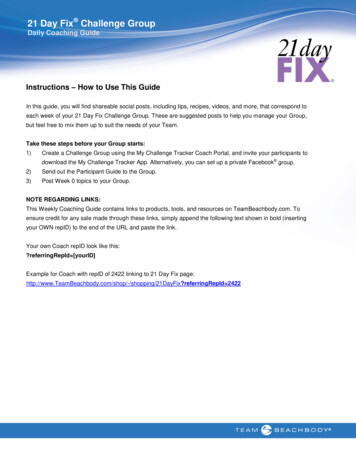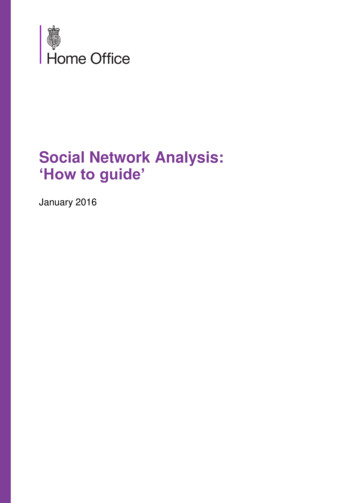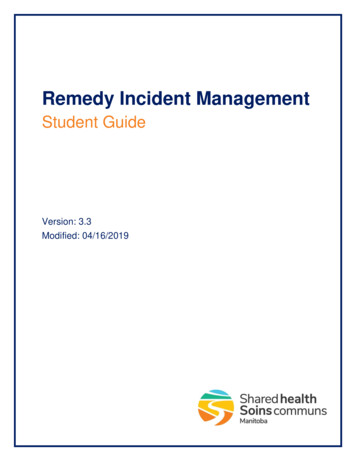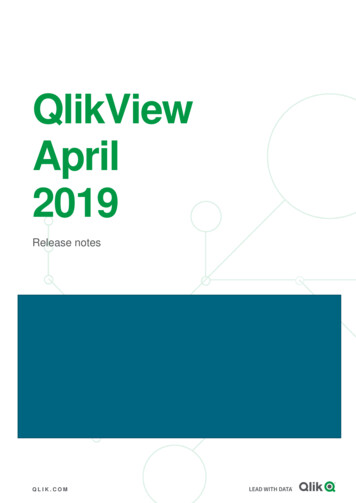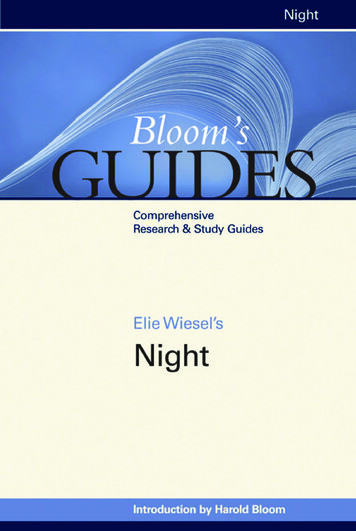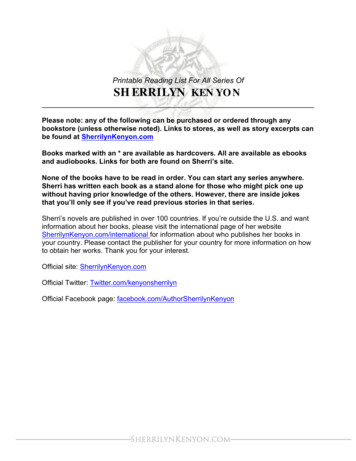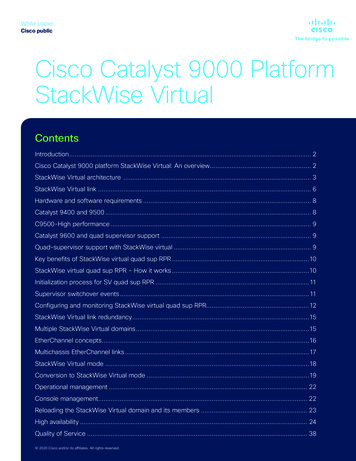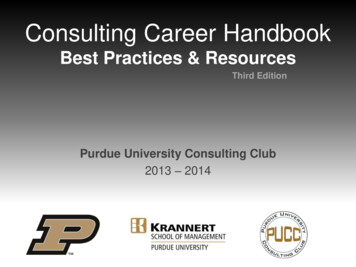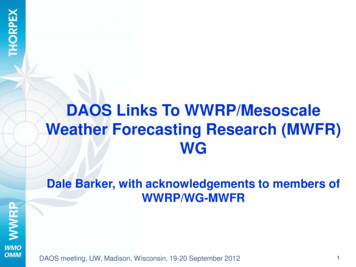
Transcription
WWRPDAOS Links To WWRP/MesoscaleWeather Forecasting Research (MWFR)WGDale Barker, with acknowledgements to members ofWWRP/WG-MWFRDAOS meeting, UW, Madison, Wisconsin, 19-20 September 20121
MWFR Membership (DA Expertise)WWRP Jeanette Onvlee (KNMI, Netherlands, Chair)Dale Barker (Met Office, UK)Kazuo Saito (JMA/MRI, Japan)Volker Wulfmeyer (Univ. Hohenheim, Germany)Stephane Belair (Environment Canada)Jimy Dudhia (NCAR, USA)Mattias Rotach (Univ. Innsbruck, Austria)Yu Hui (CMA, China)New for 2011: Peter Steinle (Bureau of Meteorology, Australia) Tiziana Paccagnella (ARPA-SIMC, Italy)DAOS meeting, UW, Madison, Wisconsin, 19-20 September 20122
UK Convective-Scale WeatherImpactsDamaging windsFlash floodsBBCBirmingham Tornado13/07/2005WWRPBFog, low cloud BCCNNLuxair crash06/11/2002 – 18 deadBBCAccident on M4near Cardiff10/12/2003Boscastle: 16/08/2004‘Weather’ variesover small scales,especially when extremeSue Ballard
WWRPNWCCourtesy Brian Golding MWFR DAOS : WWRP Activities
Comparison of NWP forecasts and STEPS/ UKPP (advection) Nowcasts ofPrecipitationRMSF error of 1hour accumulation 1mmSTEPS takes latest radarimage and advects the rainaccording to an NWP model,whilst smoothly switching toNWP rain fieldsRMSF Exp(Sum/N)0.5Sum sum(i 1,N) Log(Fi/Oi)2WWRPwhereO radar estimate, F forecastBoth smoothed to 6kmClive PierceRMetS data assimilation meeting 20/06/2012
Operational NWP Configuration:2013-2014Global 17km 70L (80km top) Hybrid 4DVAR (40km inner-loop) 60 hour forecast twice/day 144 hour forecast twice/day 44/12member 33km Short-RangeEPSWWRPUKV 1.5km 70L (40km top) 3DVAR (hourly) 36 hour forecast, 4 times per day 12 member 2.2km High-ResEnsemble
WWRPMWFR Activities Focus on 0.5-5km grid size models, extratropics Major focus to promote convective-scale RDP testbeds (e.g. COPS,B08RDP, Vancouver2010, HYMEX, TOMACS, Sochi2014, etc). Arrange/host dedicated workshops (e.g. ‘Use Of NWP In Support ofNowcasting’, Boulder, August 2011 - BAMS summary article). Involvement in WMO Symposium organisation (DA, NWC). Liaison with other WMO WG (e.g. THORPEX/TIGGE-LAM,WWRP/NWC, JWGV, WGNE, ). No joint MWFR/DAOS activity asyet. Last (5th) meeting 10-11 September 2011, Berlin. Next May 2013, inMontreal,Canada.7DAOSmeeting, UW,Madison, Wisconsin, 19-20 September 2012
Completed RDPs(see previous DAOS talk for more details)COPS: Dedicated QJRMS issue,2011: Beijing 2008 RDP: BAMS ArticleWWRP DAOS meeting, UW, Madison, Wisconsin, 19-20 September 20128
Field campaign in TOMACS (2011-2013)A field campaign in the Tokyo metropolitan area with a dense observation network is conductedby MRI1, NIED2 and 12 research institutions in the summers 2011-2013, as a testbed for deepconvection.MRI C-bandSolid-state MPRadarKu-band Fast ScanMP Radar2DVD RadarCalibration siteMTSATRapid ScanX-NET(NIEDS and cooperative org.)JMA OperationDoppler RadarsScintillationMeterDense SurfaceDoppler LidarsNetworkJMA LightningDetection SystemsMicrowaveradiometersWind ProfilersWWRPGPS ReceiversRadiosondeHumid Warm Air International RDP project in preparation Interest expressed by research groups in 10 countries Draft plan tbd at international kickoff meeting Oct 2012Relatively Cool Air9
Social Experiments on Extreme Weather Resilient CitiesTarget: Local Heavy Rainfall in Urban AreasSubject 1: Field Experiments TOMACSMany types of deep convection are generated inthe warm season in the Tokyo Metropolitan area【Meteorology】To obtain new insight on mechanisms of extreme weather(1) Development of new technologies(2) Field campaign in the Tokyo area (3) Statistical analysisNew observation facilitiesto Issue More Accurate and Adequate WarningSubject 2: Early Detection and Prediction SystemField campaign in theTokyo Metropolitan areaUnderstanding themechanismto Evaluate and to Adapt the Nowcasting SystemsSubject 3: Social Experiments【Sociology】Developments collaborating with end users(1) Extreme weather nowcasting methods(2) Development of test-beds of nowcasting systems(3) Extreme weather databaseMonitoring/NowcastingEvaluation and adaption the developed nowcasting system(1) Social experiments in rescue services, risk management,infrastructure and education(2) Recommendations for extreme weather resilient citiesWWRP【Engineering】System10Hazard MapNowcasting
FROST-2014: FORECAST and RESEARCHin the OLYMPIC SOCHI TESTBEDWWRPTo improve, develop, demonstrate, and exploit: Enhanced nowcasting observations inwinter complex terrain; mesoscale (250m-2km) deterministicforecasts of meteorological conditions incomplex terrain environment; regional EPS forecast products ( 7kmres); nowcasts of high impact weatherphenomena in complex terrain.To improve understanding of physics of high impactweather phenomena in winter complex terrain:To demonstrate/deliver forecasts in real time toOlympic forecasters and decision makers in order toverify and quantify societal benefits of nowcasts andforecasts THORPEX/DAOS meeting, Met Office, 27-28 June 2011
WWRPThoughts on DAOS/MWFR Links WWRP/MWFR (convective-scale DA, 1day) complementsWWRP/THORPEX/DAOS (Global DA, 1- 14day). MWFR closest links so far with other WWRP groups: Nowcasting,Verification, etc. Existing/potential MWFR/DAOS interactions: Shared expertise in DA (caveat: we need to think differently forconvective-scale, e.g. technique, observation sensitivities, etc). Should MWFR provide guidance on high-res. DA for futureglobal DA (e.g. cloud/precip DA)? Provision of optimal LBCs for MWFR RDP/FDPs (WGNE?). Treatment of large-scales within high-resolution DA. Observation selection for low/high-res DA. Assess added value of high-res. vs global/regional NWP/DA.DAOS meeting, UW, Madison, Wisconsin, 19-20 September 201212
Cloud resolving 4DVAR with cloud microphysics(Kawabata et al., 2011; Mon. Wea. Rev.)Kessler warm rain process was implementedin LT/ADJ models.WWRP4DVAR assimilation of Doppler Radar’s Radial Winds Radar Reflectivity GPS precipitable water vapor Surface observations (wind, temperature)
Scientists showing interest WWRP Korea: Pugyon National Univ., D.-I. Lee (2DVD, Pol.radar, nowcasting and modeling)Yonsei Univ., S.-Y. Hong (boundary layer and cloud microphysics)Ewha Womans Univ., S.-K. Park (sensitivity analysis and optimal parameter estimatioUSA: CSU, V. Chandrasekar (DFW )NCAR, J. Sun (data assimilation)Univ. Georgia, M. Shepherd (urban meteorology)CAPS/OU, M. Xue (NWP nowcasting, data assimilation, radar meteorology)Univ. Massachusetts, B. Philips (social experiments at D-FW)Brazil: Sao Paulo Univ., A. Pereira (nowcasting and modelling)Australia: CAWCR, P. Steinle (nowcasting, data assimilation)Austria: ZAMG, Y. Wang (nowcasting, ensemble)Canada: EC, P. Joe (nowcasting), S. Belair (urban modeling)Germany:DWD, H. Reich (data assimilation)Hong Kong: HKO, P.-W. Li (radars and nowcasting)China: Nanjing University, K. Zhao (radar meteorology, modeling)
Milestones Field campaign: Summers of 2011-2013Symposium and Kickoff meeting International symposium on extreme weather on Urban area23-24, October, 2012, Tokyo (Okuyo Hall) TOMACS RDP Kick-off Meeting25, October, 2012, Tsukuba (MRI or NIED)WWRP RDP Proposal: April, 2013RDP International Workshops: Autumn, 2013-2015
OrganizationWWRP International Science Steering CommitteeLocal organization committeeInternational Advisory Board
WWRPOther (possible) new projects WG-MWFR members participating in: PPP project INCA-CE SAB Proposal to cooperate with JWGFVR in ICP2 project(intercomparison of spatial methods in complex terrain, usingCOPS (and HYMEX?) data) Role in Lake Victoria project under consideration Role in TM-related activities under considerationJSC meeting, 11-13 April 201217
Workshop “Use of NWP in support of nowcasting”Joint WGNR-WG-MWFR Workshop, August 2011, Boulder.Aims: Strengthen interaction between NWP and NWC communities Confront present and future prospects of NWP for NWC withchallenges of NWC, recommendations on way forwardWWRP 45 participantsArticle for BAMS in preparationWorkshop considered necessary and useful by participants,wish expressed for follow-up workshop in a few yearsJSC meeting, 11-13 April 201218
HiRCoT12 WWRP Workshop in Vienna, February 2012Aims: review status, prospects and challenges of high-resolutionmodelling in complex terrain and the problems thereinSessions on limitations in parameterizations, numerical issues,input data and initialization, and computational issuesIntroductory presentations, much discussionParticipants: 30WMO support requested/used to make participations more“world-wide”“High-resolution numerical modeling in complex terrain is a hotissue, many groups have the same problems (and some havealso solutions) and all this is worthwhile to be shared in thecommunity.“A publication summarizing the discussions and conclusions isintended.JSC meeting, 11-13 April 201219
Various other activities WWRP Preparations for workshop on physiographic data (temporarilyhalted)Organization of LAM EPS training for duty forecasters incooperation with EUMETCAL (March 2012)Activities aiming at promoting international exchange of radarvolume data within Europe for research and operational purposes(assimilation in NWP models) Contacts EUMETNET/SRNWP and OPERA Radar data for HYMEX SOPJSC meeting, 11-13 April 201220
Meetings/contacts WWRP Last WG-MWFR meeting: Berlin, September 2011New members from China, Australia. 9 members.Contacts with JWGFVR Joint meeting, Berlin, Sept 2011 verification of clouds, extreme weather, LAM EPS, . Organize ICP2?Contacts with WGNR Workshop on use of NWP as tool in support of nowcasting Nowcasting Symposium, Rio de Janeiro August 2012 Common activities in FROST14, Hymex, TOMACS, INCA-CE,Lake Victoria, Contacts with WGNE/GASS Grey zone experimentation Physiography workshop?Thorpex/DAOS: WG-MWFR participationTIGGE-LAM: chair ex-officio member of WG-MWFRJSC meeting, 11-13 April 201221
WWRP6. Liaison with the Dallas Fort Worth Urban WeatherDemonstration
Major COPS Results and Conclusions1) Logistics: Data collection and harmonization, common visualizationtools, air traffic control, data base, .2) Processes:better understanding of processes influencing convective precipitationover orography (behaviour of evapotranspiration, CAPE and CIN,influence of thermodynamically-induced flow on convective initiation,.)WWRP3) Model performance and verification: Extensive validation ofconvection-permitting vs coarser models(overestimation of transpiration at low soil moisture, too deep BL overmountains, vertical wind too low in convergence zones, windward-leeeffects leading to displacement of convergence zone triggering CI atwrong locations, better diurnal cycle of precip and QPF by convectionpermitting models.)
Major COPS Results and ConclusionsWWRP4) Demonstration of new observations: Water-vapor and temperature lidar: very high vertical and temporalresolution as well as accuracy. GPS STD and tomography very useful for studying moisturevariability. VERA and C-band Doppler radar (partly dual-Doppler) applied fordetection of convergence zones. Combination of ground-based and airborne sensors investigatedaerosol-cloud microphysics. Lidar aerosol data improved the simulation of precipitation duringSaharian dust outbreak over COPS area. Much more can be exploited with the COPS data set, emphasis should beon studying ABL and microphysics. New lidar technology available for long-term operational measurements.
Major COPS Results and ConclusionsWWRP5) Data assimilation and predictability: Positive impact of the assimilation of GPS STD on QPF. Positive impact of Doppler radar and reflectivity. 3DVAR provides benchmark for DA systems on the CP scale Orography can increase the predictability of convection. The lead time is not limited by the lifetime of convective cells but bythe lifetime of the forcing conditions leading to convection. Multi-model ensemble provided improved simulation of convectivecells (14 h lead time). COPS and D-PHASE data can be used as DA testbed but testing andcomparison of different DA techniques still needs to be done. More impact studies possible. COPS-D-PHASE data set unique for verification studies.
HYMEX/TTM4 WWRP One of the (newest) task teams of HYMEX, led by a WG-MWFRmemberAim: set up testbed for DA based on HYMEX SOP data;organize/perform data assimilation experiments on e.g.: Improved assimilation techniques (flow-dependent, hybridensemble assimilation, ) Impact of new high-resolution observation types and how tomake the best possible use of them Rapid update cycling, spinup, balance and usefulness ofmesoscale models/analysis systems for nowcastingInterest for participation gathered, solidify plans in next meeting atHYMEX workshopJSC meeting, 11-13 April 201226
Volker Wulfmeyer (Univ. Hohenheim, Germany) Stephane Belair (Environment Canada) Jimy Dudhia (NCAR, USA) Mattias Rotach (Univ. Innsbruck, Austria) Yu Hui (CMA, China) New for 2011: Peter Steinle (Bureau of Meteor
